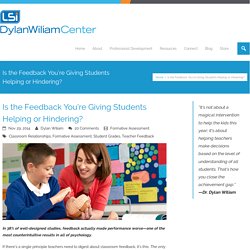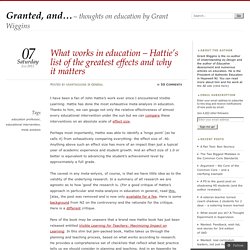

Assessment for Learning. Is the Feedback You’re Giving Students Helping or Hindering? In 38% of well-designed studies, feedback actually made performance worse—one of the most counterintuitive results in all of psychology.

If there’s a single principle teachers need to digest about classroom feedback, it’s this: The only thing that matters is what students do with it. No matter how well the feedback is designed, if students do not use the feedback to move their own learning forward, it’s a waste of time. We can debate about whether feedback should be descriptive or evaluative, but it is absolutely essential that feedback is productive. Add to that concept a second related principle: Feedback should be more work for the student than it is for the teacher. Teachers who internalize and practice feedback based on these precepts will be well on their way to teaching that improves learning. What the Studies Say Let’s examine what must be the oldest and most common forms of feedback in public education: grades, rankings, and written teacher comments on tests and papers. Formative assessment - Dylan Wiliam - Video search. CambridgeUnivGuide AfL. QIA Assessment for learning guide. AssessmentforLearning.
Hattie's 8 Mindframes. Questioning and Feedback: Top Ten Strategies. As part of our whole staff training at Huntington School we have been sharing ideas and collating ‘Top Ten Strategies’.

This list is the fruits of our labour: 1. Differentiated questioning. Given the time we take doing it daily, effective questioning may well be the highest impact strategy we can employ. There is no ‘one size fits every class’ strategy. 2. Giving waiting time for answers to our questions is something we do instinctively. 3. Being prepared with a strategy for students saying ‘I don’t know’ is clearly essential. 4. We have focused on this as a school and will continue to do so. 5. After feedback we need to make sure that we have students actively responding to their feedback. 6.
This is a simple analogy to make the layers of assessment clear. 7. Students need to understand the specific command words in their subject discipline and breakdown the different types of questions/topics etc. What works in education – Hattie’s list of the greatest effects and why it matters. I have been a fan of John Hattie’s work ever since I encountered Visible Learning.

Hattie has done the most exhaustive meta-analysis in education. Thanks to him, we can gauge not only the relative effectiveness of almost every educational intervention under the sun but we can compare these interventions on an absolute scale of effect size. Perhaps most importantly, Hattie was able to identify a ‘hinge point’ (as he calls it) from exhaustively comparing everything: the effect size of .40. Anything above such an effect size has more of an impact than just a typical year of academic experience and student growth. And an effect size of 1.0 or better is equivalent to advancing the student’s achievement level by approximately a full grade. The caveat in any meta-anlysis, of course, is that we have little idea as to the validity of the underlying research. Can you guess the next two items on the rank order list? “Home environment” and “socio-economic status.” Like this: Like Loading... What can we learn from John Hattie.
Ask not what works; instead ask: what works best?

‘Perhaps education’s equivalent to the search for the holy grail…’ (TES) “It is my ambition to say in ten sentences what others say in a whole book.” Friedrich Nietzsche, 1885 A casual glance through John Hattie’s CV shows just how prolific an educationalist he is. By 2007, he was on 8 editorial boards, including the British Journal of Educational Psychology, had written 12 books, supervised 168 PhD theses, published 546 papers, given over 700 public talks plus innumerable professional development sessions since 1989, and run workshops for thousands of teachers in thousands of schools.
Hattie has also collated the largest ever collection of evidence-based research in the educational world. His next book, Maximising Impact on Learning (2012), the biggest ever research project on teaching, took the numbers to over 900 meta-analyses over 18 years. “Now you see it…”: the magic of direct instruction and feedback. Ten sentences in his own words: